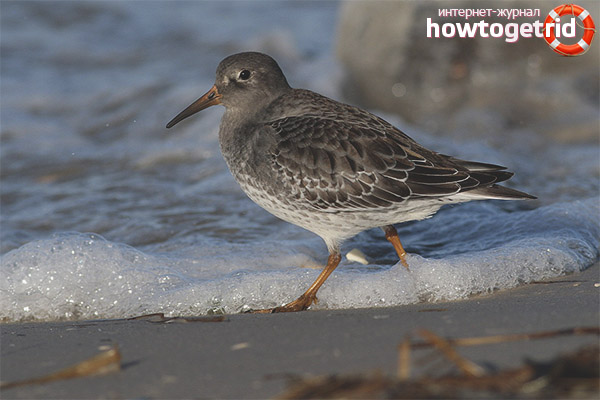The content of the article
Under the sea sandbox is meant a bird from the snipe family, living preferably in water sources, as the name implies. Birds differ in their attitude to humans, they are not at all afraid of people and can exist with them on the same territory. Oversized waders grow in size up to approximately 20 cm, but representatives of the family met much more in nature. As for the wingspan, these figures fluctuate within 40 cm. But let's not get ahead of ourselves, step by step we will study the main features of birds.
Description
- When an individual puts on his outfit in the mating season, it looks quite variegated. The area behind the neck is bright, feathers on the shoulders and back are reddish with ocher inclusions. Often, when dressed in a wedding outfit, birds do not lose particles of gray plumage left over from the winter period.
- Individuals who have barely crossed the threshold of a year old look rather tired. They have an untidy appearance that has not yet formed in terms of the color of plumage to the end. When the representatives of the group grow up, they acquire a grayish hue in the winter. Young animals in August and September also practically do not differ, the upper part of the head is gray, dark.
- A distinctive feature of the younger generation is that the speckles in the chest area are brighter than in adults. And the feathers in the parietal part, on the shoulders and back are narrow, white with a border of an ocher tone. It looks contrasting.
- As for winter vestments, clear contours cease to be so. The ocher is lost, the look itself is blurry. In the sternum, on the lateral parts of the body, feathers are dull and gray.
- Birds living in the eastern side of Europe are classified as nominative subspecies. Compared to other members of the family, these birds are squat, downed, with a short neck, middle legs and dark feather color.
- If we compare a seabird, for example, with a dunlin, the first one has no spots on the chest. Also, the legs of the birds are painted orange with a yellow undertone. The beak is dark in shade, even black. At the base of the beak there are faded orange particles of color.
- Individuals are common in the vastness of our homeland. They prefer to live in the tundra. They are also present on the Arctic islands. For wintering, these birds necessarily fly to Russia, live near icy areas and snowy areas.
Nutrition
- Often, in search of food, the considered individuals live on the shores of various reservoirs and stones protruding from the water. Also, birds can often run on seashores at low tide. In such places, birds feast on a large accumulation of brown algae.
- In addition, the birds often include in their diet all kinds of worms, mollusks, insects, crustaceans and fry. Also, birds sometimes feed on green algae. In some cases, with insufficient food, individuals can afford to enjoy berries and various plant seeds.
- During low tide on the shore during feeding, you can observe not only sandboxes that live directly in this area, but also other birds. The latter can nest a few kilometers from the mainland tundra.
- As for the mainland itself. In its depths, individuals feed mainly on the larvae of flies, aphids, adults, riders, pupae and collembola. In addition, the diet of such birds can include annelids, spiders, plant food and snails.
- The considered individuals are often fed on food that freely lies in the open.Also, such food can be located in algae. It is worth noting that these birds, unlike relatives, do not immerse the beak in the substrate. Therefore, they do not look for food by touch.
- Often, the birds in question produce food on a slippery surface or stones. For the same reason, you can see that these birds practically do not run. They prefer to walk measuredly. In addition, sandboxes are good swimmers.
Breeding
- It is worth noting that during the mating season, the birds break into constant pairs. They are true to each other for the rest of their lives. As soon as individuals appear at the nesting sites, pairs begin to form over 5 days.
- Birds make nests in the ground, in some cases under bushes. Sometimes dwellings can be seen among stones or in crevices of rocks. As a lining of the bird lay pieces of moss and various leaves. Often, the female lays up to 3 eggs.
Sandboxes are calm and peaceful birds. During the mating season, monogamous couples form. The male is predominantly involved in the siting of progeny. Closer to the birth of the chicks, the female completely leaves the nest.











Submit